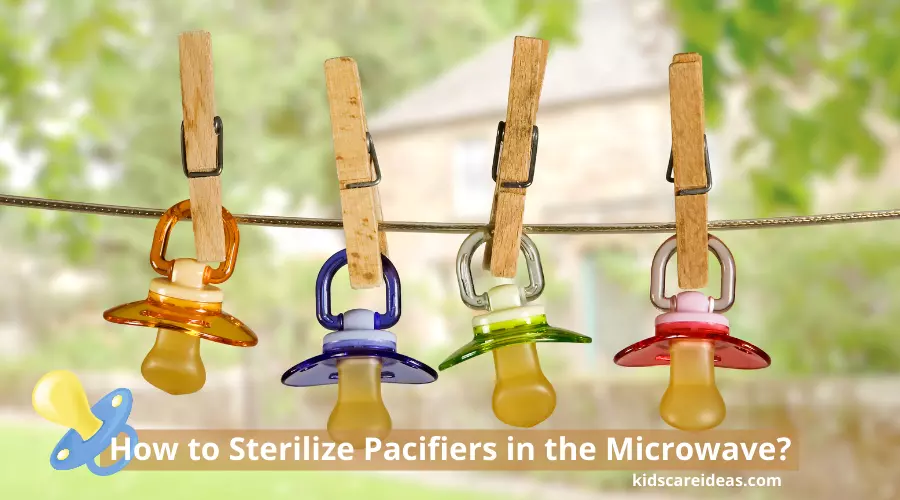Pacifiers are a great comfort for babies and toddlers alike.
Along with soothing them as they cry, pacifiers also help combat their discomfort as they teethe.
However, the hard plastic traditionally used for these items can harbor germs and bacteria if not properly sterilized.
Luckily, one of the easiest ways to keep your baby’s pacifier clean and fresh is by sterilizing it in the microwave!
Many people don’t know how to sterilize pacifiers in the microwave. It’s very easy!
The microwave is the go-to appliance for fast food reheating, but can it also be used to sterilize pacifiers?
Pacifiers are small and easy to fit in the microwave cup without preventing an even distribution of heat.
However, if your pacifier has any plastic parts, you should remove them first as they could melt and create toxic fumes.
Sterilizing pacifiers in the microwave is recommended by many experts because it kills germs. Microwaves work by heating the water molecules inside the pacifier to boiling temperature.
This temperature is sufficient to kill most bacteria and fungi.

Let’s get started!
Importance of Sterilizing Pacifier
Pacifiers are an essential part of raising a baby. They help your baby soothe their gums and fall asleep.
However, they can also source lots of germs and bacteria.
It is very important to sterilize the pacifiers before giving them to your child.
The problem with pacifiers is that germs can easily be passed from one child to another because they are passed from hand to mouth.
This means that if you don’t sterilize pacifiers, you can cause health problems for your child. You can easily sterilize the pacifiers in the microwave.
You can do this in just a few minutes.
If a baby uses a pacifier, it should be sterilized daily. Some parents choose to sterilize the pacifier by boiling it, while others sterilize it in the microwave.
How to Sterilize Pacifiers in Microwaves?
Sterilizing a pacifier in the microwave is a quick and easy way to kill all the bad bacteria that can live in a pacifier. This method of sterilizing is recommended for use only when the pacifier falls on the floor or touches something dirty.
To sterilize pacifiers, place them in a microwave-safe container and follow the steps below:
Step 1: Place a pacifier in a bowl of water
First, you need a Microwave safe bowl filled with water. You may choose to use a glass or plastic bowl in that bowl filled with water and dip the Pacifier in it to start sterilizing.
Step 2: Microwave the pacifier for one minute on high.
Next, you need to turn your Microwave settings too high and turn them on, giving a Timer of 1 minute.
You need to use Microwave mode in your Microwave oven and not Convection or any other modes.
Step 3: Cooling the Pacifier
Now, after the process is done and the Microwave Oven beeps.
You need to take out the Pacifier using tongs. Allow the pacifier to cool before removing it from the microwave.
Step 4: Keep in a Cool and Dry Surface
Now the Pacifier is sterilized, but you need to keep it on a cool and dry surface to protect it from contamination.
You can give this pacifier to your baby now.
Next time again, when it comes in contact with any surface, you need to repeat the process above to keep it sterilized and germ-free.
How Often Should You Sterilize Pacifiers?
Pacifiers need to be sterilized as often as they contact the ground or any other items. If kept safely at least once a fortnight would be good to avoid the buildup of bacteria.
Sterilizing your pacifiers and bottles is an important step in keeping your baby safe during feedings.
Watch your bottle and pacifier closely for signs of mold and mildew buildup.
Babies have sensitive immune systems and can develop a host of illnesses due to bacteria growth.
Monitor the development of mold and mildew over a month and sterilize them thoroughly once you begin to see signs of growth.
FAQs on How to Sterilize Pacifiers in the Microwave
Q : How Many Seconds Should You Microwave a Pacifier For?
Ans : You can microwave a pacifier for 60 seconds. This is true for most brands of pacifiers. The time may vary depending on the brand of the pacifier.
Just place the pacifier in a microwavable container with some water and set your microwave to high for 60 seconds.
After the time has elapsed, use tongs to remove the pacifier from the water and let it air dry before giving it to your baby.
Q : What happens if you don’t sterilize pacifiers?
Ans : When it comes to the health and safety of your child, one area you should never cut corners on is with regards to the pacifier.
Pacifiers are a necessary item for most babies and toddlers.
Not only do they help to calm and soothe the baby, but they also assist in the process of weaning.
But if you don’t sterilize pacifiers according to guidelines, you risk introducing harmful bacteria into the baby’s mouth.
Not cleaning and sterilizing pacifiers is a common cause of illness for babies. Pacifiers can harbor harmful bacteria like Candida, leading to infection, so parents need to clean and sterilize pacifiers.
It is also important to keep pacifiers in a clean and safe place and out of the reach of pets and siblings.
Q: Where do you store sterilized pacifiers?
Ans: You can store sterilized pacifiers in any dry clean and covered area devoid of germs like an Airtight Ziplock bag.
Q: Can you boil pacifiers to sterilize them?
Ans: Boiling the pacifier would sterilize it, but it will only work if the pacifier is safe to be boiled.
You can boil silicone pacifiers to sterilize if the manufacturer mentions them as safe.
However, you cannot boil natural rubber pacifiers as they can get damaged due to high temperatures.
Conclusion
Let’s conclude the post on how to sterilize pacifiers in the microwave!
This article discussed when it is safe to use a microwave to sterilize pacifiers.
We will also review the best way to do so and provide some safety tips for parents. You can use pacifiers with an animal or human-shaped design in the microwave.
If you are using the microwave on one of its lower settings, make sure to keep an eye on your pacifier as it microwaves.
After reading this article, we hope that you will be able to make an informed decision when sterilizing your pacifiers.
I hope you enjoyed reading the post.



